Eating foods that cause anxiety and fear is really hard. A big part of recovery from an eating disorder (or disordered eating) is exposing yourself to these “fear foods” and learning to sit with the discomfort that comes with eating these foods. In the beginning, the discomfort is at an all time high, but over time your thoughts/feelings/emotions surrounding these foods shifts and you are able to create positive experiences instead of negative ones.
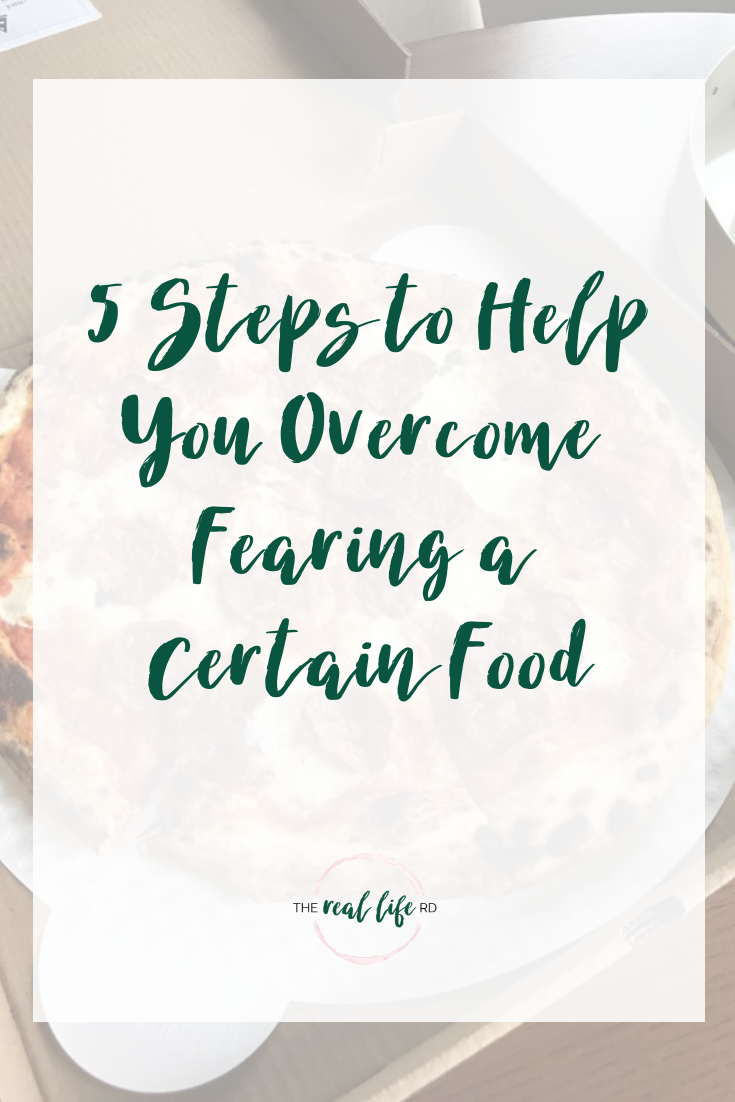
In today’s post, I’m going to walk you through the steps of a food exposure. This of course, does not replace the work you are doing in treatment (if you have a treatment team) or the need for treatment, but I hope it’s helpful for you if you struggle with unhelpful thoughts and feelings surrounding particular foods.
What do you think when you see this pizza?
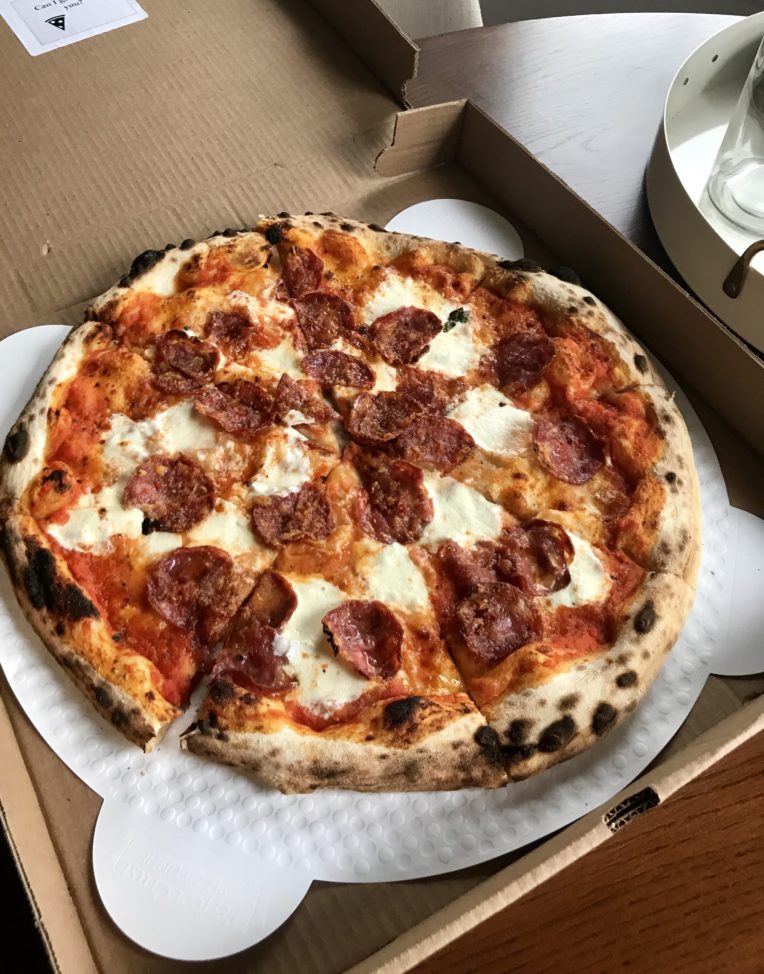
Maybe you’re like, “that looks insanely delicious, but I’d never let myself eat that.” I hear you, I was in your shoes once too. Overcoming unhelpful thoughts around food is a process. It takes time. So if you feel overwhelmed by the idea of eating a slice of pizza, maybe you can adjust the ingredients a bit so it’s still challenging, yet tolerable. The idea is to elicit enough discomfort that it’s challenging, but not too much to where you are too overwhelmed and can’t manage the discomfort. I’m going to walk you through 5 steps to help you feel less anxious/stressed/fearful around this pizza (or insert any challenging food/meal – this process is transferable)
1. Strategies to Increase Your Success
Let’s think about all the ways we can decrease your vulnerabilities so therefore, you have the best chance possible at having a positive experience with this meal.
Who can you eat with?
Eating with a safe person (a friend, your partner/spouse, etc) can be really helpful.
What time of day will you eat this?
You don’t have to tackle everything at once – maybe eating it in the morning is too much for this first go around because the idea of eating “that many calories” early in the day is incredibly distressing. Maybe for this first time, eating it at night for dinner feels more manageable.
Where will you eat? What environment feels safest?
Maybe eating the pizza on your couch while watching a show is what feels safest right now because the distraction will be helpful. Maybe eating it at a friend’s house feels safest because you can hang out together afterward and that will take your mind off unhelpful thoughts. It can be anywhere that sets you up for the most success.
2. Combating unhelpful thoughts
What thoughts do you anticipate coming up before, during and after eating the pizza? Get them all out there. Write them down. Now, how can you reframe the unhelpful thoughts into more true, realistic thoughts?
Unhelpful thought –> “That is too many carbohydrates in the crust and I will gain weight.”
Reframe –> “Carbohydrates are my body’s preferable source of energy. The carbohydrates in the crust provide healthy energy for me to start my day so I feel energized and present in my life.”
Unhelpful thought –> “Cheese isn’t healthy and will make me tired and lethargic.” Challenge that thought with, “Do I know that as fact? Have I had repeated experiences of being tired and lethargic that I can associate directly with dairy?”
Reframe –> “There are many reasons that I can feel tired and lethargic, one food is very likely not one of them. This cheese is nourishing because it contains satiating fats so I feel full, and increases the satisfaction of this pizza with it’s taste – all things that add to my health.”
Unhelpful thought –> “There are too many calories in the pizza.” Challenge that thought with, “What is too many calories? Where did I learn that? What makes that calorie amount true?”
Reframe –> “My mind is not the expert on how many calories my body needs. I am learning to trust my body instead because it is the expert.”
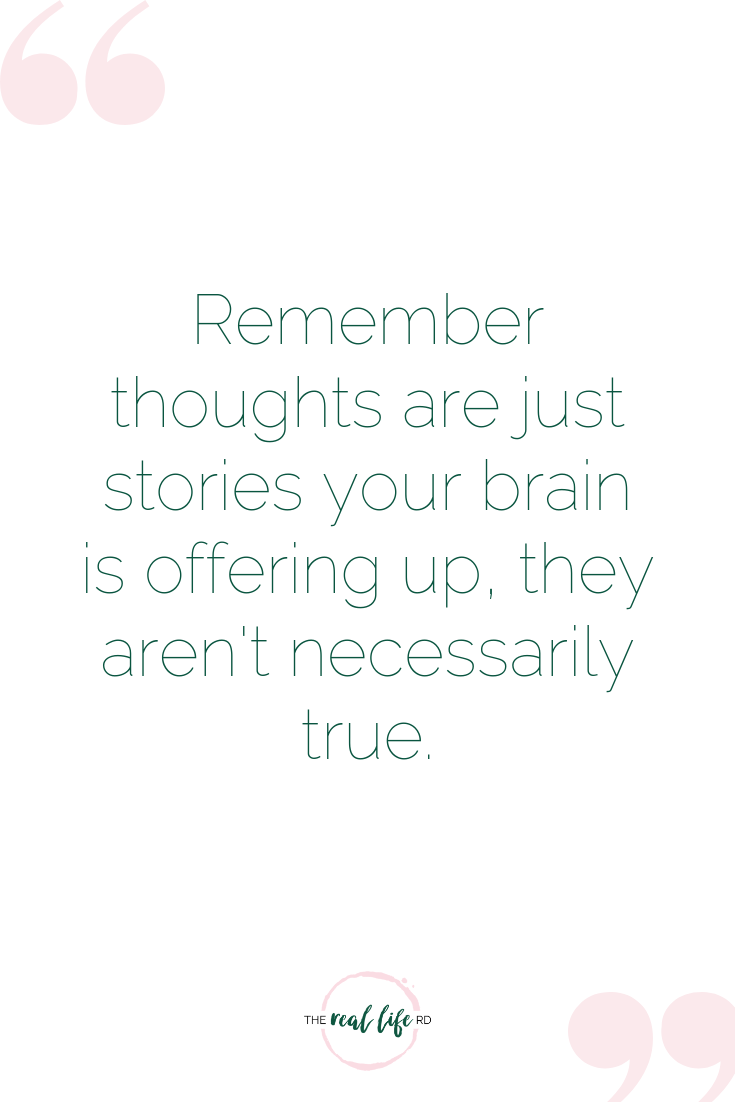
Those are just a few examples. Take some time to sit down and reframe unhelpful thoughts. Choose reframes that resonate with you most. Just because I gave it as an example doesn’t mean that is what will resonate with you. If it doesn’t resonate, it won’t be helpful so take some time to think of accurate, realistic thoughts that resonate with your healthiest self. If you find that reframing thoughts isn’t helpful another thing you can do is to defuse unhelpful thoughts, by acknowledging but not engaging with them. Simply saying, “Thanks mind!” can be helpful. Remember thoughts are just stories your brain is offering up, they aren’t necessarily true.
3. Challenging Emotions I Can Anticipate
What are some feelings and emotions you expect will come up for you before, during and/or after eating. Write those down. If you have a hard time being able to name your emotions, this list of feelings might be helpful as a reference.
4. Coping Tools to Manage Your Feelings
Now that you’ve identified what feelings might come up for you, let’s think about some tools you can use to help you feel your feelings, but not become completely overwhelmed by them to where you engage in unhealthy behaviors (restricting, going back to dieting, exercising to burn off the calories, body bashing, purging, negative self talk, etc)
Some tools that clients have found helpful that you might find helpful too are…
- calling a friend during/after eating
- repeating the healthy reframes in step 2
- remembering and thinking about your values
- taking a stroll (not a power walk) around the block to calm yourself down
- texting a safe person to let them know how you’re feeling
- deep breathing for 1-5 minutes
- journaling your thoughts/feelings
- listening to your favorite music
- doing some gentle yoga or stretching
5. Reflecting on lessons learned for the next time around
When trying to heal your relationship with food, it’s going to be messy. There will be many bumps in the road. But those bumps and messy moments that feel like failures are really how you learn and grow if you can see them that way. When something doesn’t go as you hoped it would, you can reflect back and think about what you learned. What was challenging? What would you do differently next time? How could you strategize and plan for things to go differently next time?
I hope this exercise gives you strategies and tools on your own journey towards food peace and becoming an intuitive eater. Five years ago I could have never imagined eating pizza that was delicious, satisfying and truly healthy (physically, mentally and emotionally) without second thought.
And remember, wherever you are in your food journey, know that with time, patience, compassion and hard work…food can and will be just food. Something to nourish your body, enjoy with others, and find pleasure, joy and satisfaction in.
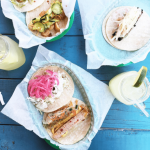
![Behind the Scenes of Intuitive Eating [A Day of Eats]](https://www.thereallife-rd.com/wp-content/uploads/2018/09/41061084_274638653368439_758303487158124544_n-150x150.jpg)













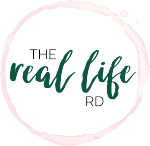
This is a great post! I especially love the reframing part because it makes us realize that our minds can make these automatic assumptions about health that aren’t really healthy at all.
P.S.- That pizza looks GOOD. I may have to get some pizza later. 🙂
The mind can make up all kinds of stories – doesn’t mean they are true or helpful! Glad you enjoyed the post Angie
This is really helpful. I admit that I feel nervous just looking at that pizza! More so over the lack of control I know I would have if I had a piece. I’m getting there with recovery, but one thing I find helpful is eating with friends who just eat and don’t worry about food being ‘healthy’, gluten-free, paleo, or anything else we are told food must be. Watching them eat intuitively is so encouraging and I find I get caught up talking to them about everything but food which stops me from dwelling on food rules. I also find it helpful to make a note at the end of the day about a food goal I accomplished. Food example the other day I wrote ‘I had pancakes for breakfast, they were delicious and it was okay.;
that’s totally okay to be in that place Rosamund – I’ve been there at one point too! Being around other people that have a peaceful relationship with food can be incredibly freeing, I’m glad you have those people! And YES. Celebrate all those little victories!
Pulling out all stops today to have one of my favourite date scenes at the coffee shop I go to. I love them…but creates so much fear and anxiety. It is a recovery goal of mine this week with my dietitian….so today is the day! Thanks for this post 🙂
Rooting for you Megan!!
Super helpful post, thank you!
Glad it helped Emily!
Great post Robyn, this is helpful for so many people. I loved how you outlined some steps and coping mechanisms!
Thank you Sarah! Hope you are well 🙂
It is so true that reframing a lot of the thoughts that have come from diet culture into the thoughts that are actually true about how that food will help and nourish my body is SO GOOD. It’s hard to remember those things in an unsafe environment, so it’s good to always start conquering those fear foods in a safe environment and gradually move onto other environments.
Yes, you have to take the baby steps.
One food I have been scared of are Cheerios, specifically the flavored ones like Honey Nut. I am scared of the sugar and GMOs. I would generally choose oatmeal or safer cereal brands. Do you have any advice on this? I am in an eating disorder recovery program and when we eat cereal we need 1 1/2 cups plus 1 cup whole milk and two eggs.
I find that I am more and more OK with any foods but the time of day that I eat them plays a big role in that. I still struggle with eating sugar in the morning or not at “meal times”, For example : a cookie after dinner is fine but a Cookie at breakfast? I will definitely binge. i am finding it hard to challenge that1
Robyn, I’m actually afraid of pizza. What can I do to get over it?